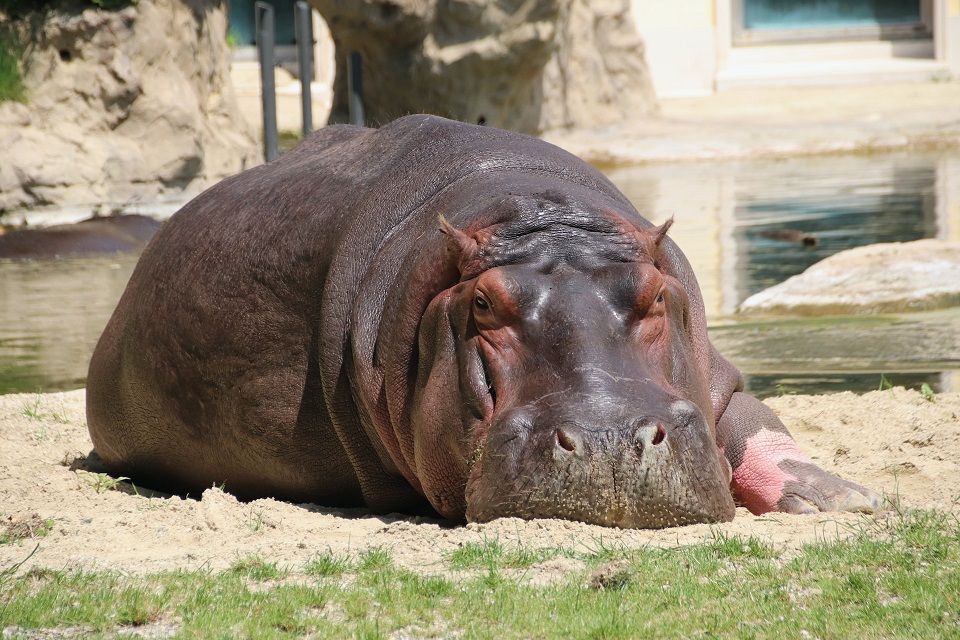Hippos are among the largest and heaviest land animals in the world, but they are not fat. This is the surprising revelation that many people on social media have recently discovered, after watching videos of hippos running, swimming, and fighting.
Many people have assumed that hippos are fat because of their bulky appearance and slow movements on land. However, this is a misconception that does not reflect the true anatomy and physiology of these amazing creatures.
Hippos have a round torso and a pinkish-brown body with two-inch-thick, waterproof skin, and short, stout legs. They might not look aerodynamic, but hippos can reach speeds of up to 22 miles per hour on land over short distances. Hippos have impressive teeth inside their huge mouths, which can open up to 1.2 metres wide. They use their teeth for fighting and defending their territory, as well as for grazing on grasses at night.
Hippos have an almost hairless body which is covered in thin skin that dries easily in the sun. That is why hippos are found wallowing in mud ponds and lakes during the day, to keep cool and moist. Hippos also secrete a thick, oily, red sweat that acts as a sunscreen and an antibiotic. This secretion is sometimes referred to as ‘blood sweat’, but is neither blood nor sweat. It is composed of two distinct pigments that are highly acidic compounds.

Details On Why Hippopotamuses Aren’t Fat
Hippos have a very low percentage of body fat compared to other mammals. Their body consists mostly of muscle, which gives them strength and endurance. Their subcutaneous fat layer is actually very thin in a relative sense. Hippos have a high density of muscle fibers, which allows them to store more oxygen in their muscles than other animals.
This helps them to dive underwater for long periods of time, up to 30 minutes. Hippos also have a large heart and lungs, which enable them to pump blood and oxygen efficiently throughout their body.
Hippos are an example of how body mass index (BMI) is not a reliable indicator of body fatness or health. BMI is calculated by dividing weight by height squared, and it is used to classify people as underweight, normal weight, overweight, or obese.
However, BMI does not take into account the difference between fat and muscle mass, or the distribution of fat in the body. Therefore, someone who has a lot of muscle mass, such as a bodybuilder or an athlete, can be considered overweight or obese by BMI standards, even though they have a low body fat percentage and are in good physical shape.
As one social media user commented: “I always thought hippos were fat but they’re actually just jacked. They’re like the ultimate bodybuilders of the animal kingdom.” This comment reflects the admiration and awe that many people feel when they learn more about the fascinating facts behind hippos’ anatomy and physiology.
Hippos are not fat: they are powerful, agile, and adaptable animals that have evolved to survive and thrive in their aquatic environment. Next time someone tells you that you’re eating like a hippo, you can tell them you’re eating like one of the most fit animals in the world.
Explore Related Articles

Is Emmanuel the Emu’s Bird Flu Diagnosis is Putting TikToker Taylor...
When it comes to famous Emus there isn't one alive that is more famous than Emmanuel. The Emu rose to fame earlier this year after appearing in TikTok videos with his owner Taylor Blake. In many of videos she has conversations with the Emu, and it almost seems as...
Prisoner Who Created Shower in his Jail Cell Using a Bottle...
It's well known that the best way for a person to unlock their true creativity is to have too much time on their hands. When a person has more free time, they can get lost in their thoughts, which unlocks new levels of ingenuity.
Ironically, one of the best ways...
Man Finds Out His Girlfriend Faked Being Pregnant Using Fake Belly...
A story of a fake pregnancy has social media scratching their heads at how it unfolded. It all started when a man found out his girlfriend faked being pregnant using a fake belly she bought off Amazon. The woman named Kayla Suber Bates even had a gender reveal party...






